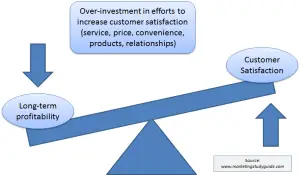Is a High Customer Satisfaction Goal Worthwhile?
The ongoing pursuit of high customer satisfaction (CSAT) scores may have a negative impact on the firm’s profitability over time.

(Click to enlarge)
While there are substantial benefits stemming from high CSAT, it is important to balance both the needs of the firm and its customers.
Because of the interplay between the consumer’s expectations and their perception of delivered value (see the overview of customer satisfaction and the disconfirmation model discussions), theoretically high levels of customer satisfaction will be generated from one of the following three scenarios:
- By building low expectations for the firm/brand and exceeding them with good value
- By building medium/high expectations for the firm/brand and exceeding them with great value, or
- By make the CSAT questionnaire an optional, say online, survey.
Each of these scenarios may have a significant and potentially quite negative impact on profitability, as outlined in the following table:
| Approach | Short-term Outcome | Long-term Outcome | Problem/s |
| Build low expectations for the firm/brand and deliver good value | Will only attract a small number of new customers, but they will be highly satisfied | Consumers will increase their expectations over time and progressively move to just satisfied | Only a small number of new customers will be attracted to the firm or brandThis provides a poor ROI on promotional activities and reduces profit per customerThe benefit of highly satisfied customers is only short-term |
| Build medium/high expectations for the firm/brand and deliver great value | Will only attract a good number of new customers, who will be highly satisfied | As consumers increase their expectations, the firm will need to improve its value and service offerings, in order to keep delighting customers | This is a significant cost impact on the firmConstant improvements are required with regular changes in products, processes and staff skills being neededIt becomes a never-ending cycle that cannot be feasibly achieved in the long-run. |
| Make the CSAT questionnaire an optional online survey | Mainly high involved customers (regular purchasers and heavy users) will participate, along with a small number of very dissatisfied consumers – this first group will dominate the survey results and are generally quite satisfied | The firm tends to tailor its marketing efforts to a smaller group of high-value customers only | While high-value customers need to be retained, the growth potential in the firm lies in its low and medium-value customers – and the firm is not uncovering (through the optional research) how to increase their relationships with them |
Customer Satisfaction and the Marketing Concept
As suggested by the marketing concept, it is important to seek to balance the needs of both consumers and the firm. If the firm works too hard by over-investing in efforts to increase customer satisfaction, say through enhanced service, price, convenience, products, relationships, then long-term profitability is likely to reduce. This relationship is shown in the following diagram.
Related Academic Research
Do Satisfied Customers Really Pay More? A Study of the Relationship between Customer Satisfaction and Willingness to Pay
Related Topics
The CSat and Profitability Paradox
